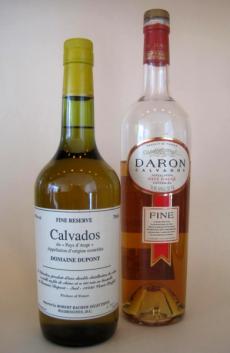
Calvados is a type of apple brandy made in Normandy, on the northwest coast of France. Calvados has had AOC (Appellation d'Origine Controlee) status since 1942, but its history is much, much older. As of 2006, there are three AOC regions for Calvados: Calvados, Calvados Pays d'Auge (which requires double distillation), and Calvados Domfrontais (which requires single distillation and 30% pears in the fruit bill).
In 1554, Gilles de Gouberville recorded in his diary that he had distilled apple cider. In 1606, a guild was formed to protect cider brandy coming from Normandy. Laws were passed banning cider distilleries outside of Normandy, Brittany, and the Maine. Many different types of apples were grown in the region, and some were chosen for sweetness, some for acidity, and some for a complex bitter aspect. These bitter varieties of apple are inedible, which shows that their destination was fermentation from the beginning.
According to the rules of the AOC, Calvados can be either column (single) distilled, or double distilled in an alembic, or pot still. It takes 18 kg (around 40 pounds) of apples to make one liter of Calvados. The apples are fermented naturally and slowly, taking four weeks to complete alcoholic fermentation. The resulting dry cider is distilled into clear apple brandy, coming from the still at no more than 144 proof. After aging, Calvados must have at least 80 proof to be sold as Calvados.
Aging in wood is a mandatory two years. At that time, Calvados can be sold as Fine or VS. An extra year grants the designation Vieux (old) or Reserve. At four years, the terms VSOP, VO, or Vielle Reserve can be used. For older Calvados, terms such as Napoleon, XO, Extra, or Tres Vielle Reserve denote Calvados with six years of aging.
If terms such as '20 years of age' are used on the label, the youngest brandy in the blend must be 20 years old. For a vintage Calvados, the brandy must be from one vintage and one distillation.
Interestingly enough, Calvados smells of apples in a strange way. Some producers recommend that the best way to drink Calvados is to pour a glass and let it sit for 15 to 20 minutes to release the complex aromas. The empty glass can smell quite strongly of apples in a way that the brandy does not.
Calvados is a fantastic ingredient - it can be used to great effect in dishes containing pork or apples, and in desserts involving apples or pears. At Au Pied au Cochon in Paris, they have a dessert on the menu which is a sorbet of apples that come from the Pays d'Auge with a drizzle of Calvados Pays d'Auge drizzled over.
Pommeau is an apple liqueur made by a process called mutage, where apple juice is spiked with Calvados. It is sweet and around between 30 and 40 proof.
Some well known producers of Calvados are: Dupont, Boulard, Busnel, Christian Drouin, and Pere Magloire.
Some popular cocktails containing Calvados
- The Miller Shake — Añejo rum, Calvados, Coconut liqueur, Demerara Rum, Bitters, Lime juice, Lemon juice, Rich demerara syrup 2:1, Egg white, Black Cardamom
- Spring Reviver — Gin, Calvados, Elderflower liqueur, Gentiane de Lure, Absinthe, Lime juice, Gomme syrup, Orange peel
- Freudian Flip — Cognac, Calvados, Bénédictine, Bitters, Absinthe, Whole egg, Nutmeg
- The Deliverance — Bourbon, Calvados, Fernet Branca, Maple syrup
- There's a Road-Snake On Your Hammie — Calvados, Rye, Ginger liqueur, Lemon juice, Honey, Lemon, Nutmeg, Cinnamon stick
- Six Figures — Cognac, Calvados, Pear eau de vie, Herbal liqueur, Maraschino Liqueur, Orange liqueur, Bitters, Pineapple syrup, Lemon juice, Lime juice
- To Be Continued — Calvados, Maraschino Liqueur, Orange liqueur, Bitters, Lemon juice, Cinnamon syrup
- Equinox — Calvados, Bitters, Lemon juice, Cinnamon syrup, Lemon peel
- Beren & Luthien — Demerara Rum, Calvados, Lavender bitters, Orange bitters, Honey syrup, Orange flower water, Orange peel
- The Fall Classic — Rye, Calvados, Sweet vermouth, Sorel liqueur, Apple